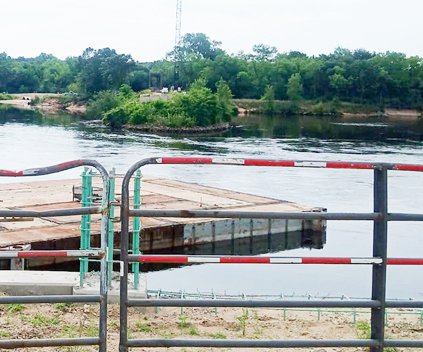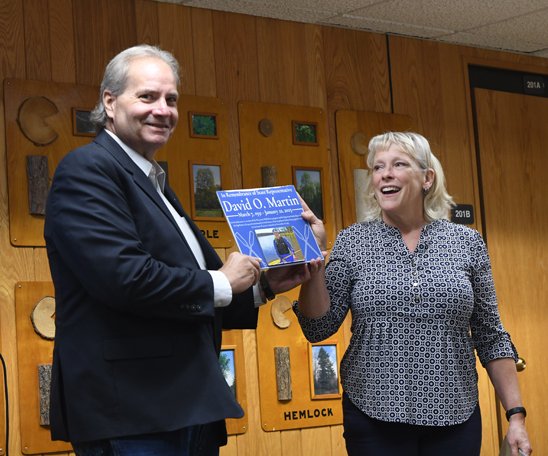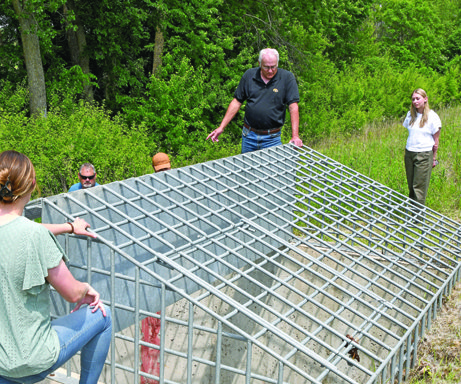The old adage, “if you build it, they will come,” seems to have rung true for the March 18 meeting of the Tainter Creek Watershed Council. Almost 65 watershed residents came out on a warm late winter day to attend the meeting, held at the Advancement Building in Readstown.
Following a delicious pulled pork sandwich dinner, various members of the original group of farmers in the watershed council shared comments with the individuals assembled.
Founding watershed council farmer-member Chuck Bolstad kicked things off in his charming way, pointing out that TCWC had a profound impact on the Driftless Region by providing an example of what could be achieved if neighbors in a watershed worked together toward common goals. Bolstad, along with his wife Karen, live in the Vernon County part of the watershed, on Stump Ridge.
“This group was always at its best when we had a project we could work on together,” Bolstad said. “We’ve reached the point where we really want to bring more people into the conversation, and see what direction an infusion of new energy and ideas can take us in.”
Watersheds explained
Longtime watershed council supporter and resident of the Trout Creek subwatershed of the Tainter Creek Watershed, Monique Hassman, explained the new geographic boundaries for the watershed to the group.
“Back in 2017, when this watershed council got started, we were encouraged to pick a smaller geographic area, so folks in a small area could get to know each other and form working relationships,” Hassman explained. “In truth, though, the Tainter Creek Watershed includes four subwatersheds – those four are Tainter Creek, Trout Creek, Reads Creek, and Kickapoo River/Caswell Hollow.”
Hassman, who is a wizard with mapmaking, and works as Vernon County’s Land Information Officer, was able to explain how watersheds are designated by the size of their drainage basins.
“HUC designations, or Hydrologic Unit Codes, are a hierarchical system used to identify and classify watersheds in the United States, with each level represented by a 2-digit to 12-digit code, ranging from broad regions to smaller subwatersheds,” Hassman explained. “So the Tainter Creek subwatershed of the greater Tainter Creek Watershed is designated as a HUC-12, but the larger area encompassing four subwatersheds is a HUC-10.”
Hassman said that the Kickapoo River Watershed is a HUC-8, so counterintuitively, the larger the watershed, the smaller the number.
“Watersheds bring together a community of folks that didn’t necessarily know they are a community,” Hassman said. “Gathering as members of a watershed council gives residents a great opportunity to share ideas about how to improve the watershed, and things that have worked well, and things that have not worked so well.”
Partners crucial
Hassman pointed out that all the amazing things TCWC had achieved over the years would not have been possible without the many partners that had helped. Those partners included:
• Valley Stewardship Network (VSN)
• Crawford Stewardship Project (CSP)
• Fishers & Farmers Partnership
• Wallace Center/The Pasture Project
• Trout Unlimited/DARE – Driftless Area Restoration Effort
• Organic Valley
• Cabela’s
• Vernon County Flood Mitigation Alliance, Land and Water
• Hill Country Watershed Alliance (umbrella organization for our sister watersheds)
- Rush Creek Watershed Conservation Council
- Bad Axe Watershed Stewards
- Coon Creek Community Watershed Council
- Other groups forming in Monroe, Juneau, and Richland Counties
• UW-Madison – Grasslanda 2.0
• DATCP
• National Wildlife Federation
• USDA/NRCS
• DAWS (Driftless Area Water Study)
• Wisconsin DNR
Grant Rudrud
The next speaker to address the group was Grant Rudrud, who farms with his sons in the Vernon County portion of the Tainter Creek Watershed, in Franklin Township. Rudrud was one of the first farmers to join the watershed council when it formed in 2017.
“I remember when Matt Emslie from Valley Stewardship Network came around after the 2016 flood, knocking on farmer’s doors and talking about forming a watershed council,” Rudrud told the group. “That led to our first meeting, and at the time Ben Wojahn, who was the Vernon County Land Conservation Director, lived in the watershed, so that really helped us get going.”
Rudrud said that they had 12 farmers at the first meeting, and at the next meeting, they had 50.
“One thing that our council did that was unique was testing well water in the watershed,” Rudrud said. “Farmers had been hearing a lot about agriculture’s impact on well water quality, so testing the water was a big step for us. When we did it, I thought that the worst well water quality in the watershed would be in wells down in the bottom, where everything collects, and boy was I surprised when the worst results turned out to be in the upland areas of the watershed, where there is more agricultural activity.”
Bruce Ristow
Bruce Ristow is another of the original farmer-members of the watershed council. Ristow conducts a grassfed beef operation on his farm in the valley along Tainter Creek, in Crawford County’s Utica Township.
“I have been testing surface water in Tainter Creek for the last 15 years,” Ristow told the group. “I love trout fishing, and I want to see local landowners exercise local control over the health of the stream.”
Big projects
VSN’s Genesis Gordon spoke about the projects their group had assisted the watershed council with. In the early days, that was just about everything. However, two larger projects have documented how watershed council activities have helped to protect the health of the creek. Those are long-term water quality monitoring at numerous locations in the watershed, and the grazing project, undertaken with the Wallace Center/The Pasture Project.
Gordon pointed out that there were pads of post-it notes on the tables, and encouraged participants to write down “what you want stewardship in your community to look like.” Those comments were collected, and will be summarized and shared at the next meeting.
“Our long-term water quality testing, on behalf of the watershed council, has shown a dramatic decrease in phosphorous levels in Tainter Creek,” Gordon said. “This improvement in water quality is a result of the conservation projects and land management practices implemented by this group.”
Gordon explained that the grazing project undertaken with the Wallace Center/The Pasture Project, used funding from an Environmental Protection Agency grant to implement transitioning of land to managed rotation grazing, or improving existing grazing systems, on 14 farms in the watershed.
“The project achieved a meaningful improvement in livestock management practices in the watershed, and had a profound impact on surface water quality in Tainter Creek,” Gordon enthused. “All of the farmers that participated in the project are still rotationally grazing their cattle, and the water quality improvements continue to compound every year since the project was implemented – our water quality testing results are the proof in the pudding.”
Closing comments
Chuck Bolstad ended the formal portion of the meeting by thanking everyone for attending. He said that the group will hold their next meeting in June, with date, time and location to be released soon.









